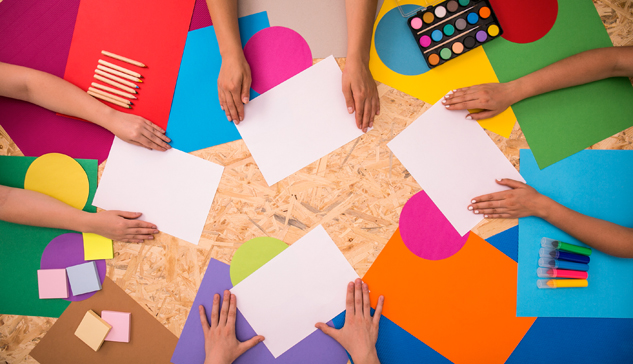
Integrating the Arts Into Your Program
By Beth Ruff, Ed.D. | May 2025

One of the mantras of Generation Alpha is “I’m built different.” Truer words have never been spoken about our current student population. Our students are struggling with myriad mental health problems, difficulty managing their emotions, poor conflict resolution skills and trouble regulating impulsivity. They are “built different” and traditional strategies that we have used to connect and engage with our students are not as effective. Adapting to the next generation of learners allows school counselors to remain relevant and impactful in students’ lives. Specifically, school counselors can support and connect with students by integrating the arts and sensory activities into their comprehensive school counseling program.
By integrating the arts with ASCA Student Standards: Mindsets & Behaviors for Student Success into school counseling instruction, school counselors can increase engagement while students build and practice skills related to social/emotional, academic and career domains. Research has shown positive connections to student self-regulation and focus and decreases in disruptive behaviors when arts integration strategies are combined with social/emotional learning and skill modeling. Integrating the arts transformed how I support students and my comprehensive school counseling program and I am excited to share some arts integrated strategies.
Integrating the arts into your school counseling program can increase engagement and connection with generation alpha students. Arts integration combined with school counseling instruction aligned with ASCA Student Standards: Mindsets & Behaviors for Student Success can increase student success in the social/emotional, academic and career domains. These visual arts, music, dance and drama strategies are effective, kid-tested activities to enhance your comprehensive school counseling program.
For additional resources, contact author Beth Ruff, Ed.D., at drbethruff@gmail.com or follow on Instagram at @theartsyfartsycounselor.
By integrating the arts with ASCA Student Standards: Mindsets & Behaviors for Student Success into school counseling instruction, school counselors can increase engagement while students build and practice skills related to social/emotional, academic and career domains. Research has shown positive connections to student self-regulation and focus and decreases in disruptive behaviors when arts integration strategies are combined with social/emotional learning and skill modeling. Integrating the arts transformed how I support students and my comprehensive school counseling program and I am excited to share some arts integrated strategies.
Visual Arts
When we teach students about arts skills and how to apply them to their lives, we are teaching them self-awareness. Encouraging students to describe the color, line, shape, texture and pattern of their emotions can help students become more mindful of their feelings. One specific strategy to support empathy and perspective taking is to ask students create a feelings collage. I discuss the collage work of Henri Matisse and field students’ responses on what they see when they look at the collages. Rarely do students provide the same answers, leading to a discussion on respecting/accepting differing views and perspectives. Students are then given the opportunity to create their own feelings collage with colored paper by cutting and gluing shapes that represent their feelings. Sharing their collages with peers allows students to build and practice social awareness and empathy.Music
Listening to music has long been associated with regulating our emotions. Incorporating mindful moments with classical or instrumental music into your classroom instruction helps students practice self-management. Another way to integrate music into your school counseling program is through lyrics analysis. For example, I created a suicide prevention lesson with older elementary students using REM’s “Everybody hurts” and Bill Whithers’s “Lean on Me.” The students listen and reflect on the lyrics of each song. Through group discussion, they decipher the importance of when to ask for help, whom to ask for help, and helping others during times of struggle. For students struggling with grief and trauma, lyrics analysis and personal playlists help them discover their voices.Drama
School counselors are naturals when it comes to using drama strategies such as reenacting scenarios and role play. I utilize dramatic role play and collaborative sculpting in my school counseling program to help students build communication and cooperative skills. For example, to support students in building conflict resolution skills, small groups of students are tasked with creating a scenario and tableaux based on a Norman Rockwell painting depicting a conflict. The students work collaboratively to come up with a second tableaux of a peaceful resolution.Dance and Movement
Dance and movement provide a nonverbal outlet to express emotions, which can be particularly helpful for those who struggle to articulate their feelings. Further, when we move and dance with others, we build relationship skills. Dance and movement can also increase self-awareness and self-confidence. One way I use dance to build confidence and positive relationships is by combining it with the book “Giraffes Can’t Dance” by Andreae Giles. The book discusses various dance genres and I provide video examples so the students can practice each dance. Just as the main character finds the courage to dance his own dance, at the end of lesson, the students create a soul train line to show off their own individual dances.Integrating the arts into your school counseling program can increase engagement and connection with generation alpha students. Arts integration combined with school counseling instruction aligned with ASCA Student Standards: Mindsets & Behaviors for Student Success can increase student success in the social/emotional, academic and career domains. These visual arts, music, dance and drama strategies are effective, kid-tested activities to enhance your comprehensive school counseling program.
For additional resources, contact author Beth Ruff, Ed.D., at drbethruff@gmail.com or follow on Instagram at @theartsyfartsycounselor.